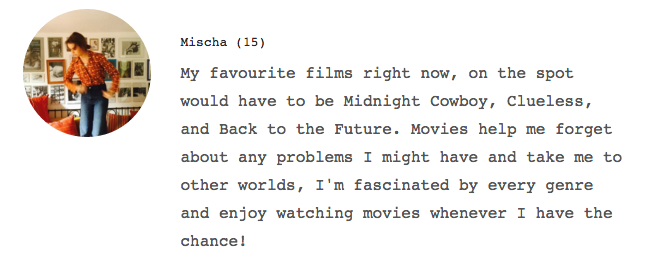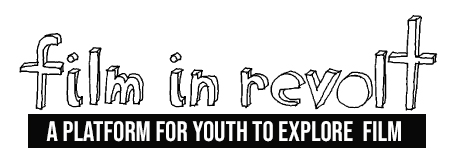By Mischa (15)
I went along to the Sydney Underground Film Festival last month to catch Don’t Blink – a documentary about the photographer Robert Frank.
Robert Frank’s work opened up a unique way to view the world through his photography especially with his series The Americans. His photography also displayed a raw nature of people, taking photos of people without them noticing was much more appealing and it evoked more emotion and told a story without any words.
Director Laura Israel revealed that there is so much more to Robert’s work then his revered The Americans collection and Don’t Blink explored how he was able to experiment in order to find his own way in taking his photos and making films. Laura went in depth about his family and I found his wife’s work (June Leaf) particularly fascinating too. I got to learn a lot about his life besides his photography and the documentary also gave some insight into his character, and the interviews with him showed that he could be at times a little prickly yet a constant joker.
I really enjoyed Don’t Blink and after watching, I needed to pick up my camera and capture the world as soon as I got out of the cinema. Robert Frank’s photography changed my view on taking photos, and it got me excited to continue with my passion.
I was very fortunate to be able to ask the director Laura Israel some questions about filming with Robert and making Don’t Blink.
What was the experience like filming with Robert?
I am lucky because Robert and I actually have had a long lasting relationship. He trusts me, and I respect him. I would say that one of the most challenging moments with Robert was actually asking him to participate initially. He declined a lot of other directors, but once he agreed to working with me, he said ‘let’s start next week!’ I wasn’t ready for this, but figured I should just dive in.
Robert seemed like he could be quite prickly, how did you work around that?
While working with Robert, keeping a small one or two person crew definitely helped. We did find out very early that Robert was not going to take direction. He pulled up the window shade at one point and Director of Photography Lisa Rinzler asked him to pull it up again, as she had missed the shot. He quickly pulled the shade down and said that’s it! So we didn’t give him direction after that – either we got the shot or we didn’t. Knowing that early enough in the process definitely helped when trying to plan the shoots. He always threw a wrench in the plan, too. Once we were going to do a shooting day traveling with him to the Bronx and he said he wanted to go to Staten Island, but then we couldn’t get on the ferry so we went to Jersey City instead. It was nerve wracking but fun to be prepared for, and I think it made the film more organic and unexpected.
What was the most enjoyable part of working on this documentary?
I loved getting to know Robert on a more personal level. It was pretty exciting that eventually he wanted to be a bigger part of the whole process. There were countless times where Robert would call me up and be like, “hey, I have these stills, want to come see them?” It showed me that he trusted me and liked the direction we were going in. Showing June and Robert the rough cut of the documentary was also enjoyable, especially since Robert said we made his photographs come to life.
Why did you want to tell Robert’s story?
I wanted the viewer to feel like they are stepping into Robert’s world, as if they were one of his close friends – just hanging out, discussing photography, film, life, and getting to know him on a personal level. For more than two decades I have had the honor of working as his film and video. A few years ago I took a teaching job and I asked Robert for advice about how to motivate students and help develop their artistic process. He thought for a minute and replied “they would get more sitting next to me for ten minutes than anything I could say.” That statement made me realize how much my own life and work have changed through knowing Robert. I have profoundly benefitted from sitting next to him in the editing
room for the last twenty-five years and it has inspired both my creative and personal life. I am excited to be able to share this unique perspective with viewers.
How did your relationship with Robert change during the filming?
It was kind of an uncomfortable role change for me at first. I have worked as Robert’s editor for so many years, so I knew him well – now to be directing him, it was be the other way around. The funny thing is that doing the documentary was the most we have ever conversed. In the past when I edited for him we had more of a quiet understanding about the footage. We never had to explain too much, so that was a bit weird suddenly having to ask him a lot of questions.
I’d love to see a documentary about his wife, June.
June is definitely interesting enough for a standalone documentary. She demonstrates so much artistry and is very influential to Robert, but also very individual. I would love to see that documentary, too! Robert and June are two very strong people living together and working on their own but side by side. They are very individual personalities but they support each other’s work. This was a very important point for me to convey in Don’t Blink.
Can you tell me about a film or documentary that made an impact on you in your youth?
When I attended film school, Lina Wertmuller was a huge inspiration to me. Love and Anarchy, Swept Away, and Seven Beauties – these were all great films. They also had a wonderful mix of political satire and iconic style. She was one of the few female directors at the time, which is really impressive. I also love Italian cinema and was influenced by Antonioni, Fellini, and neorealism.
What are you working on next?
I want to direct more. My next project is going to be something very personal to me and very different as well. I am currently working on a script for a narrative film that has been conceptualized in my mind for a while now. I’m excited to write a script and work with actors. Working on Don’t Blink with cinematographers Lisa Rinzler and Ed Lachman helped to pave the way a bit, since they both work on documentaries as well as narrative films.
What lessons did you learn from making this documentary that you will take on your next one?
I’ve heard that as a director, there are always three films. There’s the one you started making, there’s the one you that you shoot, and then there’s the one you edit and end up with. It’s important to be open to let your expectations go and make the best film you can, but that may not be the one you set out to make.
What do you love about Roberts’ photography?
I love when Robert says his work should speak for itself, and shouldn’t need much explanation. Just experience it, get hit directly in the gut by it, without analyzing it to death. As an editor, I admire the sequencing of the photos in his book The Americans, it really tells a compelling story of his experience in driving across America without needing any words – the images are enough.
What advice would you give a young documentary maker?
Don’t ever get involved in working with someone you wouldn’t enjoy sitting down to dinner with. This was probably the best advice I have ever received, and I’ve found it to be consistently true. I would also say to surround yourself with good people. When you find talented people to work with, nurture those relationships.
Don’t Blink
Directed by Laura Israel

